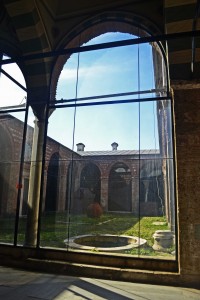
Imperial sarcophagi from the Church of the Holy Apostles, now in the atrium of Aya Irini
This giant Byzantine structure served as the Patriarchate after the Conquest, when Aya Sofya was immediately taken over as the primary mosque of the newly Muslim city. It lasted the short time that Fatih Sultan Mehmet needed to realise that the Church of the Holy Apostles was on the most impressive location in his new possession (1453 – 1456). It was already in a sad state of repair. The first incarnation of Fatih Camii was completed between 1463 and 1470 and the Holy Apostles were no more. The many rebuilds and additions, modifications and subtractions of accessory buildings have meant that anything of the Byzantine church disappeared centuries ago. An ongoing restoration of the entire complex will complete the obliteration of anything that does not remind one of the glory after 1453. (41.019311,28.950369)
The Church of the Holy Apostles was already in a lamentable state immediately prior to the Latin invasion of the fourth crusade in 1204. Emperor Alexios III Angelos, not the most reliable or stable of characters, had spent the contents of the treasury and was faced in 1196 with a demand for protection money from Henry VI of the Holy Roman Empire. Alexios had to plunder the tombs of the emperors, including Constantine the Great and Justinian, in order to raise the funds to avoid an earlier invasion. Some of the solid porphyry sarcophagi are now at the Archaeological Museum in Istanbul. They show clear signs of their desecration in 1196. All this meant was that the Latins found a little bit less to steal eight years later.
In place of the Church of the Holy Apostles, it is appropriate to display a picture of the türbe of Fatih Sultan Mehmet. This stands on the site of the church. Although the church disappeared in the 15th century, it leaves an architectural legacy in the form of a number of churches that have followed its basic cruciform structure of a dome over the centre and four more, one over each arm of the cross. These include the Basilica of St John in Selçuk (once part of Ephesus) and Basilica de San Marco in Venice. The latter undoubtedly has bits of the original Church of the Holy Apostles somewhere in its lucky-dip structure.
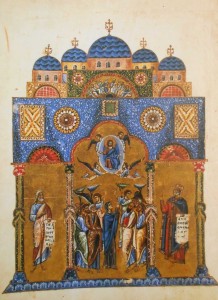 [5]
[5]An image from 1162, which matches the description of the Church of the Holy Apostles and hence probably is. Library of the Vatican.
 [10]
[10]
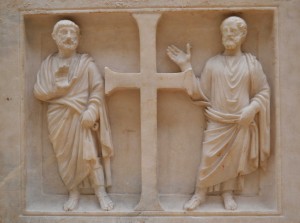
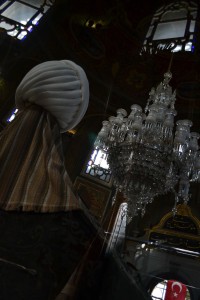
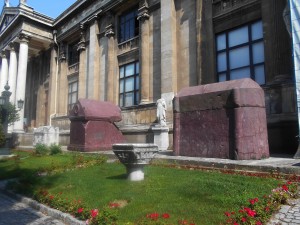
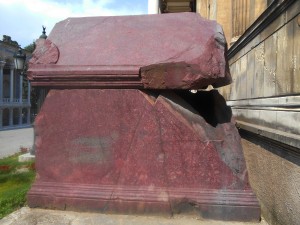
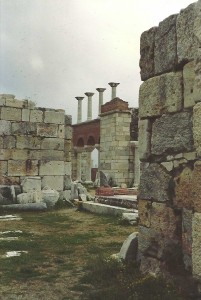
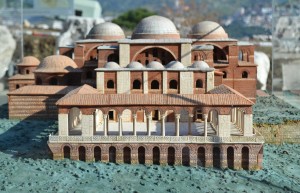
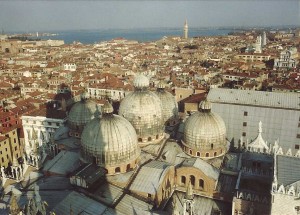
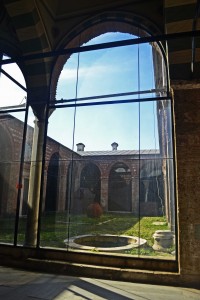
2 Comments To "The Church of the Holy Apostles"
#1 Pingback By Enormousfish | Basilica di San Marco, Venezia/Venedik | Adam Kaya Heskith | Author and Writer | Enormousfish On July 9, 2014 @ 6:28 am
[…] addition to the basilica. (45.434403,12.33932) It appears to follow the design pioneered by the Church of the Holy Apostles, once located on the great hill now surmounted by the Fatih […]
#2 Pingback By Enormousfish | Fethiye Camii/Church of the Virgin Pammakaristos/Church of the Theotokos Pammakaristos | Adam Kaya Heskith | Author and Writer | Enormousfish On November 15, 2014 @ 8:46 am
[…] on matters of theology by the conquering Sultan Mehmet, moved his HQ here in 1456 from the decrepit Church of the Holy Apostles, the site of which was required by Fatih for his fabulous new mosque. In about 1586, Sultan Murat […]